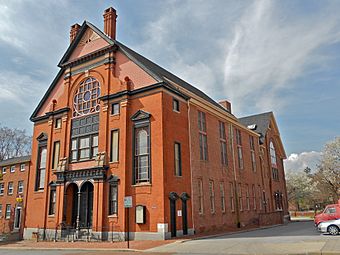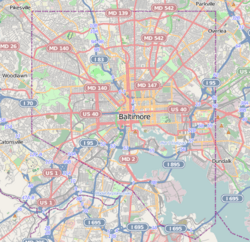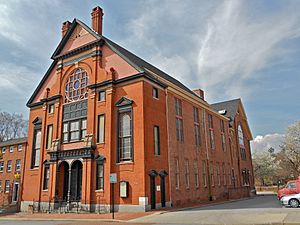Orchard Street United Methodist Church facts for kids
Quick facts for kids |
|
|
Orchard Street United Methodist Church
|
|

Orchard Street United Methodist Church, March 2012
|
|
| Location | 510-512 Orchard St., Baltimore, Maryland |
|---|---|
| Area | less than one acre |
| Built | 1837 |
| Architectural style | Renaissance, Romanesque, Italian Renaissance |
| NRHP reference No. | 75002096 |
| Added to NRHP | November 12, 1975 |
The Orchard Street United Methodist Church, once called Metropolitan Methodist Episcopal Church, is a very old and important church in Baltimore, Maryland. It was built using a mix of different architectural styles. The main part of the church was built in 1837. More sections were added later in 1853, 1865, and 1882.
The church's main building shows a Romanesque Revival style. This means it looks like old Roman buildings. A building at the back also has Romanesque features, but it includes a large Gothic window. Gothic style often has tall, pointed arches. The main worship area, called the nave, is about 54 feet wide and 75 feet long. It has special windows high up on the walls, called clerestory windows. The building at the back is about 50 by 75 feet.
The church was started in 1825 by Truman Le Pratt. He was from the West Indies and had been a slave of Governor John Eager Howard. Today, the church building is home to the offices of the Baltimore Urban League. It is also the oldest building in Baltimore that was built by African Americans.
The Orchard Street United Methodist Church was added to the National Register of Historic Places in 1975. This means it is recognized as a very important historical site. The church also has an old pipe organ from 1890, made by Henry Niemann.
Saving the Church
Lena King Lee's Efforts
Lena King Lee was an important person who helped save the Orchard Street Church. She was a member of the Maryland House of Delegates, which is like a state government group. During her time there, she worked hard to stop the church from being torn down. Her efforts helped make sure this historic building could stay standing for future generations.
More Information
- You can find more details about the church at the Baltimore Urban League website.
- Learn more about the church's history at Explore Baltimore Heritage.





